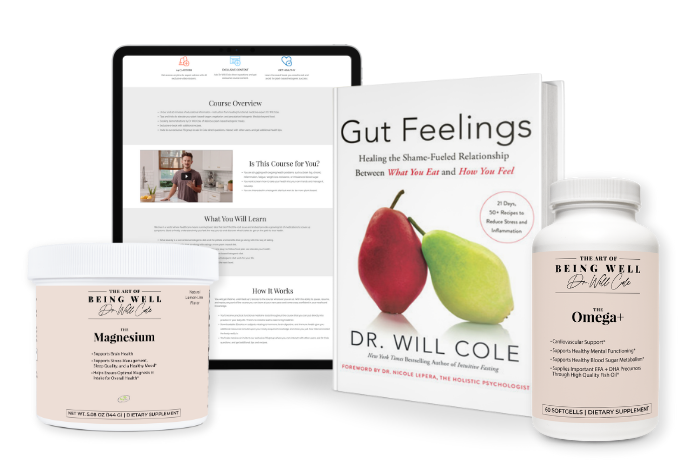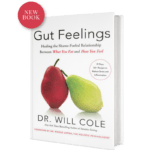Exposed To Mold? Exactly How To Get Mold Toxicity Testing To Find Out For Sure

As a functional medicine practitioner, I see countless people dealing with the damaging effects of mold exposure on a daily basis. From respiratory issues to brain problems and other chronic illnesses, mold is one of the most insidious, undetected threats to our health we face currently. And although there are no official statistics regarding the prevalence of mold, it is estimated that up to 47% of homes (1) have some sort of mold-related damage.
If you've improved your diet and lifestyle but you still feel inflamed, tired, or foggy, mold may be to blame. That’s why it is imperative for us to understand not just the signs and symptoms of mold exposure but how to test for mold exposure to know for sure. So if you believe mold is behind your symptoms, read on to learn exactly how to test for mold exposure in your home and how to get tested for mold toxicity.
ARTICLE CONTINUES BELOW
Make Your Life a Cleanse
SUBSCRIBER-ONLY GUIDES FOR GUT HEALTH, VIBRANT ENERGY, HEALTHY FOOD & CLEAN ALCOHOL
Get FREE access to these + giveaways, recipes, & discount codes in personal emails from Dr. Will Cole.
Could Mold Be a Problem In Your Home?
When I suspect mold in the home may be an issue for one of my patients, I start with two simple questions:
- Has your home ever flooded, leaked, or had water damage?
- When returning from a trip, does your home ever smell musty or like mildew?
If either of those sound familiar, these are signs that you may have a mold problem in your house. And if your answer to these questions is "no" but you're still not feeling your best, keep reading, as mold may still be a concern.
Signs and Symptoms of Mold Exposure
Mold toxicity is an insidious problem that doesn’t always have a clear set of symptoms. Mold can quietly infiltrate your living spaces, triggering a range of health concerns that you might not recognize until years later. In fact, researchers are beginning to connect the dots between mold exposure and a variety of chronic health problems, coining the term Chronic Inflammatory Response Syndrome - or CIRS for short - to encompass any sort of health problem related to mold exposure.
But with that said, there are some common symptoms that often go along with immediate mold exposure that you should be aware of. If you experience any of these symptoms, you may be living in a moldy environment.
- Respiratory problems: Persistent coughing, wheezing, shortness of breath, or sinus congestion can all be red flags, as mold spores often irritate the respiratory system.
- Allergies: Mold is a potent allergen, causing symptoms like sneezing, runny or itchy nose, itchy or watery eyes, and even worsening asthma. Mold exposure can also exacerbate seasonal allergies.
- Skin Problems: Rashes, hives, and unexplained skin irritations may also indicate mold exposure.
- General Discomfort: Chronic fatigue, headaches, or unexplained discomfort should not be dismissed, as these symptoms are often attributed to mold.
Read Next: Medical Gaslighting: Signs And How To Overcome It
Mold exposure, if left unchecked, can lead to more severe health issues over time. Again, researchers are looking deeper at the impact of mold toxicity on multiple modern-day health problems with surprising findings. On some level, mold has been implicated in a slew of long-term health problems, including:
- Alzheimer’s disease (2)
- Cancer (3)
- Cognitive dysfunction (4)
- Mitochondrial problems (5)
- Multiple sclerosis (6)
- Weight loss resistance (7)
Therefore, if you are experiencing any of these signs, it's vital to consider testing your environment for mold as a proactive measure as well as running labs on yourself to determine if you have any mold toxicity problems. To learn more about the top signs of mold exposure, check out my article here.
Step 1: Assess Your Environment
If you suspect mold exposure is a factor in your health case, one of the first steps in restoring your health is to assess your home or work for the presence of mold. You may be surprised at just how stealth mold can be, creeping up in areas of your home that you would least expect (even your car)!
At-Home Mold Testing Kits
One way to assess your environment is through at-home mold testing kits. Not only are they easy to use, they can be a more cost-effective option compared to professional evaluations. Most at-home mold testing kits typically include collection swabs, petri dishes, or air sampling cassettes, along with detailed instructions on how to collect samples from various areas in your work or home. These samples are then sent off to a laboratory for analysis or can be analyzed by you following the kits instructions.
While at-home kits can be a good choice, the effectiveness of these kits largely depends on the quality of the kit and how well you adhere to the instructions. Although they can provide a general overview of mold presence, they may not always yield definitive results, as mold species and concentration levels can be complex to interpret without professional expertise. Plus, factors like environmental conditions and mold spore activity can vary, at-home kits not as reliable.
Ultimately, testing kits can serve as a useful initial step in identifying potential mold problems, but for a more thorough evaluation and precise remediation, consulting with a certified mold inspector or environmental specialist is often recommended.
Step 2: Test Your Body For Mold Toxicity
Just like there is no one set of symptoms that indicate mold toxicity, there is also not one single test that determines if you’ve been exposed to mold. Since mold toxicity is such a complex health problem, there are many things going on beneath the surface that can indicate mold exposure depending on the specific type of mold in your environment and your particular biochemistry. Therefore, there are multiple tests that your doctor may recommend for the most accurate assessment of your health.
1. Mycotoxin labs
This is one of the first places I like to start when it comes to testing for mold exposure. These labs look for the presence of mycotoxins in your urine and antibody production against mycotoxins in your blood. They can also look for the presence of other biotoxins that are released from bacteria or viruses that can mimic mold toxicity.
2. C4a
C4a, or complement component 4a, is a protein in the immune system that plays a crucial role in regulating inflammation and immune response. When you’re exposed to mold, your immune system goes into overdrive, leading to an increased production of C4a as it attempts to combat the perceived threat from mold spores and mycotoxins. High levels are one of the most common indicators of mold exposure and can lead to tissue damage and chronic inflammation.
3. Transforming Growth Factor Beta1
While important to the health of your cells, when high, this cytokine can have (8) pro-inflammatory effects and indicate a potential mold exposure.
4. MMP-9
This enzyme works to stimulate the immune response but when high can contribute to out-of-control inflammation and is correlated with mold exposure.
5. ACTH/Cortisol
Adrenocorticotropic hormone (ACTH) controls the release of your body's stress hormone, cortisol, which can be high in cases of mold exposure.
6. SOCS3
This acronym stands for "suppressor of cytokine signaling 3," which can be elevated directly from mold exposure or from other imbalances caused by mold, leading (9) to a variety of symptoms.
7. MSH
This hormone acts as an anti-fungal and antimicrobial so when it’s low, mold toxicity is likely a factor.
8. Genetic testing
Your doctor may also want to run genetic testing as certain genetic variants within the HLA and MTHFR gene (10) families may influence your risk of developing mold toxicity.
9. Visual Contrast Sensitivity (VCS) Test
The coolest part of these tests is that they can be done online at home, often for free. They test your ability to distinguish contrast between black, white, and grey tones since certain molds can have neurotoxic effects, which can manifest as inhibited vision. You can find the VCS test online for free or for a small donation.
Step 3: How to Detox and Recover
If you test positive for mold exposure, find the source and eliminate it. Next, take additional steps to help your body recover as quickly and efficiently as possible. Here are five steps that I often recommend to my patients:
1. Supplement with glutathione
Glutathione is often referred to as the “master antioxidant” because it increases your body’s production of other antioxidants. When you’re exposed to mold, it can impact your glutathione levels (4) and sabotage your body’s defense against oxidation and free radical damage. Glutathione is sold in supplement-from but eating sulfur-rich foods, such as broccoli, cauliflower, and Brussels sprouts can also help increase glutathione production in the body.
2. Get some sunshine
Direct sun exposure has been shown to raise MSH levels, a hormone that is often low (5) when you have mold toxicity. I ask my clients to get at least 20 minutes of sunshine each day (preferably more like 60) depending on where they live and their skin tone.
3. Adopt a Ketotarian Diet
The Ketotarian diet is a mostly-plant based, anti-inflammatory diet. That means filling your plate with clean protein from vegetables and nuts and seeds, plant-based healthy fats like coconuts and avocados, and non-starchy vegetables like dark leafy greens, to support your body’s natural detoxification system.
4. Consider binders
Binders are naturally-occurring minerals that bind to mycotoxins in your system and help your body remove them. One specific type of binder is called a zeolite. Typically, zeolites are expensive so another option is activated charcoal as well as the cholesterol-lowering medication cholestyramine. One small study has suggested cholestyramine may be an effective therapeutic agent for patients with mold toxicity symptoms.
5. Bolster nicotinamide adenine dinucleotide (NAD+)
NAD+ is a coenzyme that lives in every cell of your body. Its main job is repairing damaged DNA and supporting general cellular health. You can supplement with a specific type of B3, called nicotinamide riboside, to support NAD+ levels and your cells’ ability to detox from mold.
Together, all these steps will help you determine whether mold exposure is a problem for you, fix your mold problem, and detox from the exposure using diet and natural remedies. Mold seems scary at first, but as long as you follow these steps you can recover from the inflammatory cascade caused by mold exposure.
Final Thoughts
Working with a functional medicine practitioner is one of the best ways to overcome mold toxicity. Not only will they be able to run the lab tests necessary to look at the above biomarkers, they will know how to interpret the results and translate them into actionable steps to reclaim your health.
In my telehealth functional medicine clinic, we specialize in comprehensive health care. By looking at your environment, lab work, genetics, and current lifestyle, we are able to put together a plan of action that tackles the underlying factors contributing to mold toxicity symptoms from every angle.
For further reading on mold, check out my articles on the top foods most likely to contain mold, exactly where mold can be hiding in your home, and what you can do to overcome mold toxicity issues.
As one of the first functional medicine telehealth clinics in the world, we provide webcam health consultations for people around the globe.
Photo: unsplash.com
Start Your Health Journey Today
FUNCTIONAL MEDICINE CONSULTATIONS FOR PEOPLE AROUND THE WORLD
References:
- Citation: Park, J.-H.; Cox-Ganser, J.M. NIOSH Dampness and Mold Assessment Tool (DMAT): Documentation and Data Analysis of Dampness and Mold-Related Damage in Buildings and Its Application. Buildings 2022, 12, 1075. https://doi.org/10.3390/ buildings12081075
- Vasefi, Maryam et al. “Environmental toxins and Alzheimer's disease progression.” Neurochemistry international vol. 141 (2020): 104852. doi:10.1016/j.neuint.2020.104852
- Ekwomadu, Theodora et al. “Mycotoxin-Linked Mutations and Cancer Risk: A Global Health Issue.” International journal of environmental research and public health vol. 19,13 7754. 24 Jun. 2022, doi:10.3390/ijerph19137754
- Empting, L D. “Neurologic and neuropsychiatric syndrome features of mold and mycotoxin exposure.” Toxicology and industrial health vol. 25,9-10 (2009): 577-81. doi:10.1177/0748233709348393
- Islam, M.T., Mishra, S.K., Tripathi, S., de Alencar, M.V.O.B., e Sousa, J.M.d.C., Rolim, H.M.L., de Medeiros, M.d.G.F., Ferreira, P.M.P., Rouf, R., Uddin, S.J., Mubarak, M.S. and Melo-Cavalcante, A.A.d.C. (2018), Mycotoxin-assisted mitochondrial dysfunction and cytotoxicity: Unexploited tools against proliferative disorders. IUBMB Life, 70: 1084-1092. https://doi.org/10.1002/iub.1932
- Benito-León, Julián, and Martin Laurence. “The Role of Fungi in the Etiology of Multiple Sclerosis.” Frontiers in neurology vol. 8 535. 16 Oct. 2017, doi:10.3389/fneur.2017.00535
- Yang, Zhenggang et al. “Regulation of insulin and leptin signaling by muscle suppressor of cytokine signaling 3 (SOCS3).” PloS one vol. 7,10 (2012): e47493. doi:10.1371/journal.pone.0047493
- Clark, D A, and R Coker. “Transforming growth factor-beta (TGF-beta).” The international journal of biochemistry & cell biology vol. 30,3 (1998): 293-8. doi:10.1016/s1357-2725(97)00128-3
- Carow, Berit, and Martin E Rottenberg. “SOCS3, a Major Regulator of Infection and Inflammation.” Frontiers in immunology vol. 5 58. 19 Feb. 2014, doi:10.3389/fimmu.2014.00058
- Valtonen, Ville. “Clinical Diagnosis of the Dampness and Mold Hypersensitivity Syndrome: Review of the Literature and Suggested Diagnostic Criteria.” Frontiers in immunology vol. 8 951. 10 Aug. 2017, doi:10.3389/fimmu.2017.00951
View More At Our Store
Purchase personally curated supplements
and Dr. Will Cole’s books!

The information on this website has not been evaluated by the Food & Drug Administration or any other medical body. We do not aim to diagnose, treat, cure or prevent any illness or disease. Information is shared for educational purposes only. You must consult your doctor before acting on any content on this website, especially if you are pregnant, nursing, taking medication, or have a medical condition.
Our content may include products that have been independently chosen and recommended by Dr. Will Cole and our editors. If you purchase something mentioned in this article, we may earn a small commission.

BY DR. WILL COLE
Dr. Will Cole, DNM, IFMCP, DC is a leading functional medicine expert who consults people around the globe, starting one of the first functional medicine telehealth centers in the world. Named one of the top 50 functional and integrative doctors in the nation, Dr. Will Cole provides a functional medicine approach for thyroid issues, autoimmune conditions, hormonal imbalances, digestive disorders, and brain problems. He is also the host of the popular The Art of Being Well podcast and the New York Times bestselling author of Intuitive Fasting, Ketotarian, Gut Feelings, and The Inflammation Spectrum.

Gut Feelings
Healing The Shame-Fueled Relationship
Between What You Eat And How You Feel


